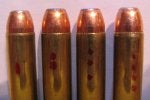Hi all,
I've just started reloading for 38 Special. For now I have only reloaded 9mm. I use the Lee 3-die set for 38/357.
I bought some flat point 158gr ( First Pic ) heads.
Which of the 4 crimps in the second pic is ideal ?? I am planning of loading relatively light as this gun is for range use only. Maybe 3.7 or 3.8 grains of Rex II. My limited experience tells me it is probably number 3 but I am not sure. I have read other posts and saw some pics but I would still like an opinion from you guys.
The state of the cases is due to repeated tests. These are range pickups which are only used for testing the Dies.
Thanks
I've just started reloading for 38 Special. For now I have only reloaded 9mm. I use the Lee 3-die set for 38/357.
I bought some flat point 158gr ( First Pic ) heads.
Which of the 4 crimps in the second pic is ideal ?? I am planning of loading relatively light as this gun is for range use only. Maybe 3.7 or 3.8 grains of Rex II. My limited experience tells me it is probably number 3 but I am not sure. I have read other posts and saw some pics but I would still like an opinion from you guys.
The state of the cases is due to repeated tests. These are range pickups which are only used for testing the Dies.
Thanks






